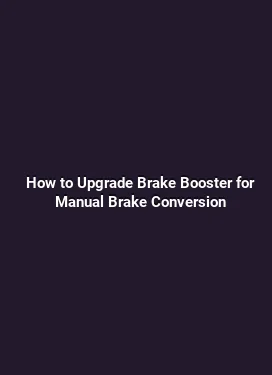How to Install a Brake Proportioning Valve for Better Rear Brake Control
Achieving optimal braking performance hinges on balancing hydraulic force between the front and rear wheels. A brake proportioning valve (BPV) is a critical component in classic and performance braking systems, helping to adjust rear brake pressure to match load, speed, and road conditions. Proper installation requires careful assessment of vehicle weight distribution, brake line routing, and the interaction with the master cylinder and anti-lock braking system. This guide delves into the practical steps, considerations, and pitfalls of selecting and installing a brake proportioning valve to enhance rear brake control and pedal feedback.
Choosing the Right Brake Proportioning Valve

The first step is understanding the type of valve that best fits the vehicle dynamics and braking goals. Proportioning valves come in several configurations, including manual singular valves and adjustable systems that tailor rear bias through a tunable spring-loaded mechanism. When evaluating options, consider the following factors:
- Vehicle weight distribution: A 60/40 front-to-rear weight split on a typical passenger car may use a valve with a moderate rear bias, while trucks or high-performance machines with heavier rear loads may require more aggressive adjustments.
- Driving conditions: Street driving demands smooth pedal modulation and predictable rear responsiveness, whereas track settings may benefit from a wider adjustment range and stiffer tuning.
- Brake system compatibility: Ensure the valve geometry aligns with existing lines, fittings, and the master cylinder output. Some systems integrate proportions through a single valve unit, while others use calibrated stacks to achieve the desired bias.
- Material and construction: Brass, stainless steel, and billet alloys offer different resistance to corrosion and temperature rise. Look for corrosion-resistant fittings and seals designed for high heat environments.
In practical terms, an adjustable brake proportioning valve provides the most versatility. It allows on-the-fly tuning to achieve the ideal pedal feel and rear damping under various loads. However, installation complexity increases with adjustment capability, so plan for careful calibration during testing.
Understanding Brake Bias and System Dynamics
The concept of brake bias refers to how hydraulic pressure is distributed between the front and rear brakes. Since the front wheels handle a significant portion of stopping power, especially under hard braking, removing too much pressure from the rear can lead to nose-diving or reduced rear stability. Conversely, excessive rear bias can cause lockup and loss of steering control. A well-tuned brake proportioning valve helps maintain stability by moderating rear pressure without compromising front bite.
Key dynamics to consider include line pressure, pedal feel, and brake fade resistance. The valve interacts with the master cylinder to ensure rear circuits do not exceed the pressure the tires can safely handle. Temperature fluctuations influence hydraulic viscosity and can alter pressure distribution, making robust seals and proper routing essential.
Installing with Respect for System Harmony

When integrating a BPV, ensure the overall brake system remains coherent. The valve should be positioned in the rear brake line, typically between the master cylinder outlet and the rear brake split, while maintaining a clean loop of routing that minimizes bending radii and avoids sharp kinks. The use of braided stainless steel lines can reduce expansion, preserving pedal travel consistency under heavy braking.
Additionally, consider compatibility with anti-lock braking systems (ABS). Some ABS architectures tolerate simple proportioning valves, while others require valve configurations that preserve wheel speed sensor signals and modulate pressure without triggering fault codes. If the vehicle relies on hydraulic pressure from the master cylinder to modulate ABS, confirm that the valve’s flow characteristics do not hamper soft-brake assist or ABS activation.
Step-by-Step Installation Guide
The following steps outline a practical approach to installing an adjustable brake proportioning valve. It is advisable to perform this work with the vehicle supported safely, the braking system bled, and with a calibrated testing plan to verify performance after installation.
-
Prepare the components: Inspect the valve for seals, fittings, and threads. Gather wrenches, thread sealant or PTFE tape compatible with brake fluid, and new copper or brass crush washers. Have a drain pan ready for any brake fluid spills and a clean rag to wipe fittings.
-
Relieve system pressure: With the ignition off, pump the brake pedal and hold to release residual pressure. If the vehicle has ABS, follow the manufacturer’s procedure to bypass stabilization components during work, ensuring a safe testing environment after installation.
-
Locate the rear brake line: Identify the line that feeds the rear brakes from the master cylinder or from a distribution block. Plan a mounting location that is protected from heat sources and vibration, yet accessible for adjustment.
-
Cut and prepare the line: If needed, cut the rear line at a point that allows the valve to be installed inline with minimal tube bending. Deburr the cut and ensure a clean, square edge to prevent leaks.
-
Install the valve: Thread the valve into the prepared segment using appropriate fittings. Use thread sealant or PTFE tape sparingly to avoid fluid bypass without compromising seal integrity. Tighten to the manufacturer’s torque specification and verify there are no cross-threaded connections.
-
Bleed the system: After installing the valve, bleed the rear brakes to remove any air introduced during work. Start at the wheel farthest from the master cylinder and work inward. Ensure that the brake fluid reservoir remains filled during the bleed process.
-
Configure bias settings: If using an adjustable valve, set an initial bias based on the vehicle’s weight distribution and typical loads. A common starting point is a slight rear bias to improve stability, then refine using a controlled test drive. Document the setting for future reference.
-
Test for proper operation: With the car on a safe surface, perform light, medium, and progressive braking tests. Look for balanced behavior, no rear lockup, and consistent pedal feel. If rear sag or instability occurs, adjust the valve in small increments and re-test until the desired balance is achieved.
-
Inspect for leaks and heat: After testing, inspect all connections for fluid leakage. Check lines for chafing and ensure the valve does not overheat under repeated braking. Replace any damaged components promptly.
-
Document performance: Record the bias setting, testing conditions, and observed pedal feedback. This data helps fine-tune the setup and provides a reference for future maintenance or performance modifications.
Calibration and Tuning Tips
Fine-tuning a brake proportioning valve is as much art as science. Here are practical tips that help translate theory into noticeable improvements in rear control and overall stopping power:
- Use a controlled environment: Conduct calibration on a closed course or quiet road with predictable traction. Environmental factors like rain, gravel, or uneven pavement can distort measurements.
- Make incremental changes: Adjust the valve in small steps, such as a quarter-turn at a time. Allow the brakes to cool between attempts to avoid heat-related fluid expansion masking true behavior.
- Monitor pedal travel: A consistent pedal feel with predictable modulation is a strong indicator of proper bias. If the pedal travels farther before braking engages, it may indicate insufficient rear pressure or air in the system that needs addressing.
- Correlate with tire grip: Real-world traction varies. Track days or spirited sessions require different bias settings compared to daily commuting. Use tire wear patterns and ABS activity as indicators for retuning.
Common Issues and Troubleshooting
Despite careful installation, issues can arise. Recognizing symptoms early helps prevent unsafe driving conditions and excessive wear on tires or rotors. Common concerns include:
- Rear lockup during heavy braking: This may indicate excessive rear bias. Reduce rear pressure and re-test. If using a high-performance tire setup, consider incremental adjustments rather than large changes.
- Pedal sponge or soft initial bite: Air in the rear circuit or excessive line expansion can cause a soft pedal. Re-bleed the system and verify line integrity and fluid quality.
- Uneven rear braking: A misrouted line or a restriction in the rear pathway can create uneven pressure distribution. Inspect for kinks, clamps, or collapsed hoses.
- ABS interference: In some configurations, the ABS module expects a specific pressure curve. If ABS activation is inconsistent, consult the vehicle’s service manual for compatibility notes and consider a valve with ABS-tuned characteristics.
Maintenance is a crucial part of sustained performance. Periodically check for corrosion on fittings, verify seal integrity, and replace any worn components before they affect braking safety. Consistent fluid quality and proper reservoir levels maintain predictable system behavior across temperature ranges and driving cycles.
Safety Considerations and Best Practices
Working with brake hydraulics demands a meticulous approach to safety. Always use proper personal protective equipment, ensure the vehicle is securely supported, and dispose of old brake fluid according to local regulations. When selecting a valve, opt for components that meet or exceed OEM standards for fluid compatibility and temperature endurance. A well-chosen, correctly installed proportioning valve contributes to predictable braking performance, improved rear stability, and a more confident driving experience in a variety of conditions.
Trend-aware insights highlight the growing emphasis on drivetrain balancing and braking system integration in modern performance vehicles. While electronic stability and advanced driver-assistance features complement mechanical tuning, the fundamentals of brake bias remain essential for drivers who pursue precise, repeatable braking behavior on road and track alike. Embracing a holistic approach—considering line routing, material choices, and the interaction with other braking components—yields lasting improvements in control and safety across the vehicle’s lifecycle.






